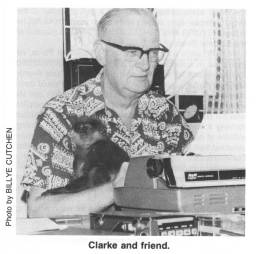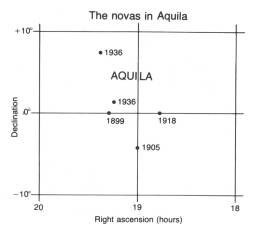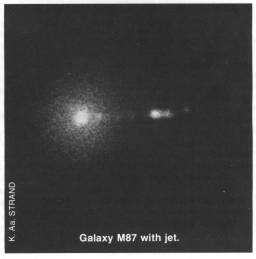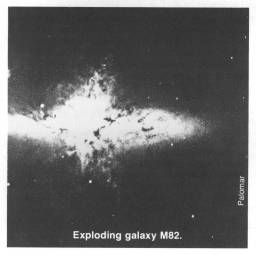Trouble in Aquila
By: Arthur C. Clarke

Clarke and friend
Reprinted from "The Scientist Speculates" by I. J. Good, General Editor, Copyright 1962. Capricorn Books, New York, $1.95. Reproduced by permission.
Some provocative, free-wheeling speculations about astronomical events.—Eds.
Bitter experience has made me reluctant to go into print with half-baked ideas — at least until I have a thorough discussion with a patent lawyer. For in 1945, I published a very far-out article ('Extra-terrestrial Relays', Wireless World, October 1945) in which I described in some detail the use of artificial satellites, particularly those in the synchronous or 24-hour orbit, as a solution to the problem of world communications. I never expected this idea to be baked in my lifetime; it now appears that I badly misjudged the heat of the oven.
Nevertheless, I have a few suggestions, of varying degrees of seriousness, which I am prepared to donate to the general scientific (and science-fictional) community. Some have been sitting in my writer's note-book for years, and as it now seems unlikely that I will ever use them, here they are for what they are worth — which is probably exactly nothing.
1. According to Norton's Star Atlas, there have been twenty fairly bright novae between 1899 and 1936. No less than five of them have been in one small area of the sky, in the constellation Aquila. There were two in a single year (1936), and the 1918 Nova Aquila was one of the brightest ever recorded.
 What's going on in this constellation? Why did 25 percent of the novae in a forty-year period appear in only 0.25 percent of the sky? Is the front line moving in our direction?
What's going on in this constellation? Why did 25 percent of the novae in a forty-year period appear in only 0.25 percent of the sky? Is the front line moving in our direction?
 2. On the same subject, possibly. The galaxy M87 has, jutting out from its heart, a luminous jet unique in the known universe. (See article by Otto Struve, 'Virgo A', in the February 1961 issue of Sky and Telescope.) This brilliant jet, according to the Russian astronomer I. S. Shklovsky, liberates as much energy as the explosion of
10,000,000 supernovae. To provide this amount of energy it would be necessary to annihilate the mass of a hundred suns.
2. On the same subject, possibly. The galaxy M87 has, jutting out from its heart, a luminous jet unique in the known universe. (See article by Otto Struve, 'Virgo A', in the February 1961 issue of Sky and Telescope.) This brilliant jet, according to the Russian astronomer I. S. Shklovsky, liberates as much energy as the explosion of
10,000,000 supernovae. To provide this amount of energy it would be necessary to annihilate the mass of a hundred suns.
If this calculation is correct, astronomers have some explaining to do. No natural process is known - and it is hard to conceive of one - that could totally annihilate a hundred suns. Some concentrations of energy are so abnormal that they can be explained only by deliberate and intelligent planning. The explosion of an H-bomb is one obvious example: is the M87 jet, despite its stupendous scale, another? We, who have progressed from steam engines to thermonuclear reactions in a couple of centuries, should have such powers at our command in a thousand, or a million years.
Perhaps this extraordinary - indeed, unique phenomenon appeals to me because of some lines I wrote in the novel The City and the Stars (1954). If I may be allowed to quote myself:
Man was about to leave his Universe, as long ago he had left his world. And not only Man, but the thousand other races that had worked with him to make the Empire. They were gathered together, here at the edge of the Galaxy, with its whole thickness between them and the goal they would not reach for ages.
They had assembled a fleet before which imagination quailed. Its flagships were suns, its smallest vessels planets. An entire globular cluster, with all its solar systems and all their teeming worlds, was about to be launched across infinity.
The long line of fire smashed through the heart of the Universe, leaping from star to star.
In a moment of time a thousand suns had died, feeding their energies to the monstrous shape that had torn along the axis of the Galaxy and was now receding into the abyss . . .
That last paragraph might well be a description of the M87 jet. Perhaps the truth, if we ever discover it, may turn out to be even more remarkable.

Postscript by Arthur C. Clarke written in Colombo, Sri Lanka, July 23, 1978:
This little squib was written in 1961 as a contribution to the fascinating volume "The Scientist Speculates: An Anthology of Partly-Baked Ideas", 1962, edited by Irving J. Good (Capricorn Books, New York). That was shortly before the rise of the modern Explosive Astronomy and the discovery that all hell seems to be breaking loose all over the universe.
The concept put forth in this essay is not original, and the idea that we should look for the products of "astronomical engineering" has been perhaps best expounded by Freeman Dyson. But nowhere as concisely as by Stanley Schmidt in his novel "The Sins of the Fathers" (Berkeley 1976), which contains the chilling phrase: "Seyfert galaxies are industrial accidents."
Arthur C. Clarke has written 50 books, about equally divided between fiction and non-fiction. In many SETI has been a dominant theme. Millions of copies have been printed and sold in over 30 languages. Perhaps best known is his "2001, a Space Odyssey." Other well-known ones are "Profile of the Future" and "The Promise of Space," both non-fiction, and his fiction works, "Childhood's End", "Imperial Earth" and "Rendezvous with Rama." His latest novel, "The Fountains of Paradise" is being published currently. It is about Sri Lanka from 150 AD to 4000 AD and has many SETI overtones.
A special quality of Arthur Clarke's science fiction is that it is usually so close to real science that it is difficult to distinguish the difference.
Arthur Clarke was born at Minehead, Somerset, England, in 1917. He graduated from King's College, London, with First Class Honors in physics and mathematics. He is a Fellow of the Royal Astronomical Society and a past chairman of the British Interplanetary Society and for two years (1948-50) he edited PHYSICS ABSTRACTS. Currently he is a member of the Editorial Board of COSMIC SEARCH.
In 1945, while a radar officer in the Royal Air Force, he published an article in WIRELESS WORLD which described the use of artificial satellites and, in particular, those in geostationary orbit, as a solution to the problem of world communication. This was a dozen years before Sputnik and six more years before the first successful geostationary satellite was put into orbit (1963). Now there are many such satellites forming a kind of Saturn's ring around the earth handling millions of conversations daily. In 1962 the Franklin Institute awarded their gold medal to Clarke for originating the satellite communication concept. Some of his other pioneering suggestions include the electromagnetic launcher for transporting lunar material for space enterprises and the placing of human space habitats at the stable Lagrangian libration points lying in the moon's orbit.
In 1962 he received the Kalinga Prize for science writing from UNESCO and in 1969 he won the American Association for the Advancement of Science-Westinghouse science-writing prize. His science fiction awards include the Hugo and the Nebula.
Arthur Clarke lives now in Sri Lanka, off the coast of India, with no plans to leave, unless, as he says, "there's a seat for me on the Space Shuttle." Though no longer writing, he is a voracious reader, spending "36 hours reading every 24."
| ![[NAAPO Logo]](../../Images/NAAPOsm.jpg)
![[NAAPO Logo]](../../Images/NAAPOsm.jpg)